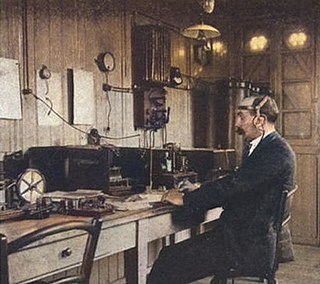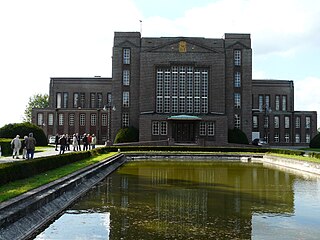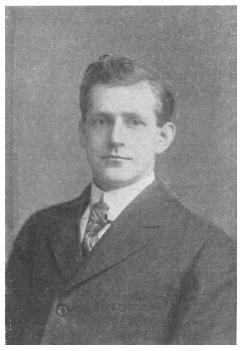Related Research Articles

Guglielmo Giovanni Maria Marconi, 1st Marquis of Marconi was an Italian inventor and electrical engineer, known for his creation of a practical radio wave-based wireless telegraph system. This led to Marconi being credited as the inventor of radio, and he shared the 1909 Nobel Prize in Physics with Karl Ferdinand Braun "in recognition of their contributions to the development of wireless telegraphy".

Wireless telegraphy or radiotelegraphy is transmission of text messages by radio waves, analogous to electrical telegraphy using cables. Before about 1910, the term wireless telegraphy was also used for other experimental technologies for transmitting telegraph signals without wires. In radiotelegraphy, information is transmitted by pulses of radio waves of two different lengths called "dots" and "dashes", which spell out text messages, usually in Morse code. In a manual system, the sending operator taps on a switch called a telegraph key which turns the transmitter on and off, producing the pulses of radio waves. At the receiver the pulses are audible in the receiver's speaker as beeps, which are translated back to text by an operator who knows Morse code.

SOS is a Morse code distress signal, used internationally, that was originally established for maritime use. In formal notation SOS is written with an overscore line, to indicate that the Morse code equivalents for the individual letters of "SOS" are transmitted as an unbroken sequence of three dots / three dashes / three dots, with no spaces between the letters. In International Morse Code three dots form the letter "S" and three dashes make the letter "O", so "S O S" became a common way to remember the order of the dots and dashes.
Telefunken was a German radio and television apparatus company, founded in Berlin in 1903, as a joint venture of Siemens & Halske and the Allgemeine Elektrizitäts-Gesellschaft (AEG).
The Radio Act of 1912, formally known as "An Act to Regulate Radio Communication", is a United States federal law which was the first legislation to require licenses for radio stations. It was enacted before the introduction of broadcasting to the general public, and was eventually found to contain insufficient authority to effectively control this new service, so the Act was replaced and the government's regulatory powers increased by the passage of the Radio Act of 1927.

The invention of radio communication was preceded by many decades of establishing theoretical underpinnings, discovery and experimental investigation of radio waves, and engineering and technical developments related to their transmission and detection. These developments allowed Guglielmo Marconi to turn radio waves into a wireless communication system.
The timeline of radio lists within the history of radio, the technology and events that produced instruments that use radio waves and activities that people undertook. Later, the history is dominated by programming and contents, which is closer to general history.
The Wireless Ship Act of 1910, formally titled "An Act to require apparatus and operators for radio-communication on certain ocean steamers" and also known as the "Radio Ship Act of 1910" and the "Radio Act of 1910", was the first federal legislation regulating radio communication in the United States. It required certain ocean-going vessels exiting U.S. ports to carry radio equipment, and although it did not require stations or operators to be licensed, it did require certification that operators and radio equipment met minimum standards.
A radiogram is a formal written message transmitted by radio. Also known as a radio telegram or radio telegraphic message, radiograms use a standardized message format, form and radiotelephone and/or radiotelegraph transmission procedures. These procedures typically provide a means of transmitting the content of the messages without including the names of the various headers and message sections, so as to minimize the time needed to transmit messages over limited and/or congested radio channels. Various formats have been used historically by maritime radio services, military organizations, and Amateur Radio organizations.

Georg Wilhelm Alexander Hans Graf von Arco was a German physicist, radio pioneer, and one of the joint founders of the "Society for Wireless Telegraphy" which became the Telefunken company. He was an engineer and the technical director of Telefunken. He was crucial in the development of wireless technology in Europe.

Adolf Karl Heinrich Slaby was a German electronics pioneer and the first Professor of electro-technology at the Technical University of Berlin (1886).

Nauen Transmitter Station in Nauen, Havelland district, Brandenburg, Germany, is the oldest continuously operating radio transmitting installation in the world. Germany's first high power radio transmitter, it was founded on 1 April 1906 by Telefunken corporation and operated as a longwave radiotelegraphy station through World War II, and during World War I became Germany's main link with the outside world when its submarine communications cables were cut. Upgraded with shortwave transmitters in the 1920s it was Germany's most advanced long range radio station, continually upgraded with the latest equipment and serving as an experimental station for Telefunken to test new technology. At the end of World War II, invading Russian troops dismantled and removed the transmitting equipment. During the Cold War it served as the GDR's international shortwave station Radio Berlin International (RBI), and was the East Bloc's second most powerful radio station, disseminating Communist propaganda to other countries. Since German Reunification in 1991 it has been operated by Deutsche Telekom, Germany's state telecommunication service. The original 1920 transmitter building designed by architect Herman Muthesius is still used; it is the only remaining building designed by that architect.
The second International Radiotelegraph Convention met in London, England in 1912. It adopted international maritime radio communication standards that updated the ones approved by the first International Radiotelegraph Convention held in Berlin in 1906. The new Convention was signed on July 5, 1912, and became effective on July 1, 1913.
The Deutschland incident of 1902 occurred in March of that year, and resulted from the refusal of Marconi Company coastal radio stations to provide services to shipboard stations that were operated by competing companies.

Harry Shoemaker was an American inventor and pioneer radio engineer, who received more than 40 U.S. patents in the radio field from 1901 to 1905. His transmitter and receiver designs set the standard for the U. S. commercial radio industry up to World War One.
Robert Henry Marriott (1879-1951) was an American electrical engineer, and one of the first persons to work in the field of radio communication. In 1902 he engineered the first commercial radiotelegraph link established in the United States by a U.S. company, connecting the island of Santa Catalina with the California mainland. He founded the Wireless Institute professional society in 1909, which was merged in 1912 with the Society of Wireless Telegraph Engineers to form the Institute of Radio Engineers (IRE), and served as the IRE's first president.

The Marconi Wireless Telegraph Company of America was incorporated in 1899. It was established as a subsidiary of the British Marconi Company and held the U.S. and Cuban rights to Guglielmo Marconi's radio patents. American Marconi initially primarily operated high-powered land and transatlantic shipboard stations. In 1912, it acquired the extensive assets of the bankrupt United Wireless Telegraph Company, becoming the dominant radio communications provider in the United States.
Australasian Wireless relates to two separate entities: Australasian Wireless Limited and Australasian Wireless Company Limited. The former obtained an option to acquire the exclusive rights to the Telefunken wireless telegraphy system in Australasia, the latter acquired those rights and with public capital developed a firm which was successful in supplying wireless telegraphy equipment to shipping in Australasian waters and the establishment of Australia's first coastal radio stations. When the Australian Government decided to complete the remainder of the coastal network using the Balsillie wireless system manufactured by Father Archibald Shaw, AWCL merged with Marconi interests to form Amalgamated Wireless (Australasia). This merged firm eventually won the exclusive right to operate Australia's coastal radio network and went on to become the dominant company in Australia's radiocommunications and broadcasting industry.
The first International Radiotelegraph Convention was held in Berlin, Germany, in 1906. It reviewed radio communication issues, and was the first major convention to set international standards for ship-to-shore communication. One notable provision was the adoption of Germany's "SOS" distress signal as an international standard.
References
- 1 2 "Objections to Monopoly", History of Communications-electronics in the United States Navy by Linwood S. Howeth, 1963, pages 70-71.
- ↑ "The Slaby-Arco Portable Field Equipment for Wireless Telegraphy" by A. Frederick Collins, Scientific American, December 28, 1901, pages 425-426.
- ↑ "Recent Wireless Telegraphic Developments", The Electrician, April 4, 1902, pages 942-943.
- ↑ "Z.: Final Protocol: Article I: Section 2" "Final Protocol: Preliminary Conference Concerning Wireless Telegraphy", August 13, 1903, page 12.
- ↑ "The First International Radio Telegraphic Conference, Berlin, 1903", History of Communications-electronics in the United States by Linwood S. Howeth, 1963, pages 71-72.
- ↑ "The Second International Radio Telegraphic Conference, Berlin, 1906", History of Communications-electronics in the United States by Linwood S. Howeth, 1963, pages 118-124.